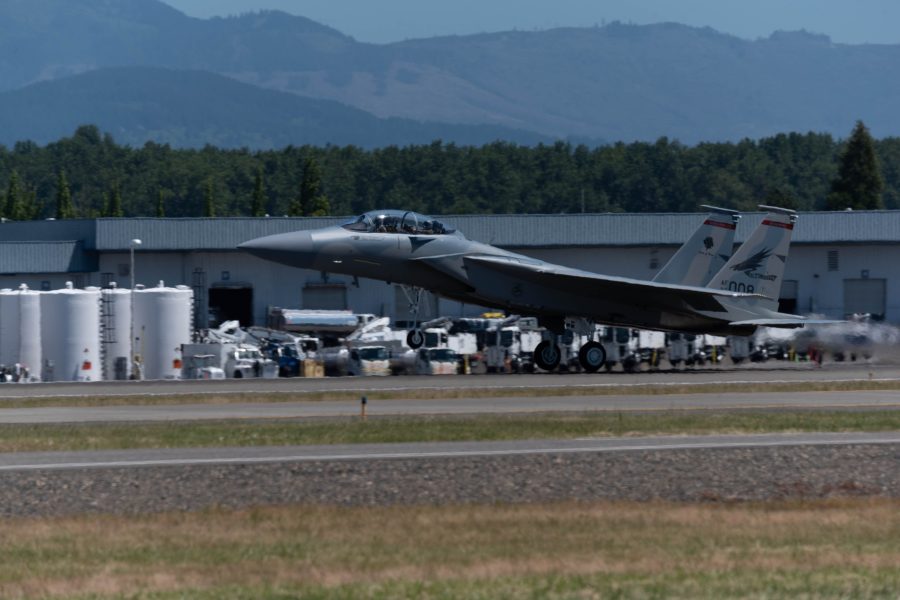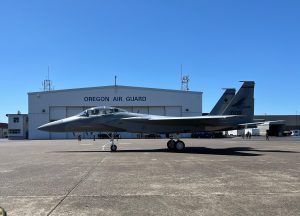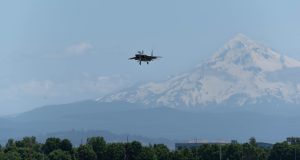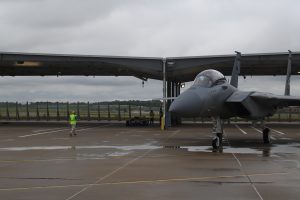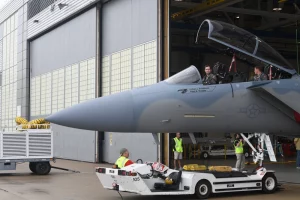The first operational F-15EX Eagle II was delivered to Portland Air National Guard Base, Ore., on June 6, the first all-new weapon system to be delivered to the Air Guard before serving with the Active-Duty force.
The aircraft, serial #008, is the first of 18 that will serve with the 142nd Wing of the Oregon Air National Guard. Another 13 are slated to arrive within the next year, and four more in the years after that. Military construction is underway to accommodate the influx of new airplanes, which will backfill F-15C/Ds at the base. The jet was flown directly from Boeing’s production facilities in St. Louis, Mo., to Portland.
“It’s incredibly exciting, super humbling,” 142nd commander Col. Michael B. Kosderka of the Oregon Air National Guard told the Armed Forces News Network.
“This is the first time, to my knowledge, that an Air National Guard Base got a major weapon system before the Active component. So it’s a super big deal that the Guard is getting to have this major weapon system, first.”
Aircraft #007, already painted and undergoing final checks, will be delivered in the next two weeks, a Boeing spokesperson said. The aircraft at Portland bear a stylized Eagle tail flash unique to the wing.
Previously delivered F-15EXs are being used in a combined Developmental/Initial Operational Test and Evaluation program, Phase 1 of which—including participation in 19 exercises—was completed last fall.
The EX program is about a year behind schedule, but Boeing will hit its contractual marks if it delivers the remainder of Lot 1B—five more airplanes—in the coming weeks. The jet is based on the F-15QA developed for Qatar. Indonesia has declared its interest in buying the EX version as well.
Originally planned to number 144 aircraft, the F-15EX fleet is now anticipated to top out at 98 aircraft, according to the Air Force’s fiscal 2025 budget request. Lawmakers on Capitol Hill, voicing concern about the Air Force’s decreasing fighter inventory, have indicated they may add more F-15EXs in the 25 budget.
The F-15EX, which was originally inserted into the 2020 budget by the Pentagon leadership over the Air Force’s objections—it wanted to buy more F-35s instead—is now welcomed by the service as a complement to the F-35, and one which can be absorbed in the fleet more rapidly. Whereas it takes two years or so to equip a wing with new F-35s, the transition from F-15C/Ds to the F-15EX typically takes only a few months, the Air Force has said. Eagle pilots easily adapt to the F-15EX’s fly-by-wire handling and new displays, and the jet can use all the same aerospace ground equipment used by the F-15C/D.
In addition to being new with fresh engines—Kosedrka said they seem quieter than the older F-15s—the EX has additional sensors, a much more powerful processor, a new glass cockpit, and an additional weapon station under each wing. The only obvious physical difference from the F-15C are missile warning blisters on either side of the canopy rail.
However, the fourth-generation F-15EX is not a stealthy aircraft and costs about the same as an F-35 at around $80-$90 million per plane. Boeing has pushed back against the “fourth generation” descriptor, arguing that the aircraft’s electronic warfare suite, the Eagle Passive Active Warning Survivability System (EPAWSS), gives the fighter significantly more capability to approach highly contested airspace than the F-15C/D.
The jet can also carry oversize munitions that won’t fit in the F-35’s weapons bay, such as anticipated hypersonic missiles.
While the bulk of the F-15EX fleet is to have conformal fuel and weapons pallets—similar to those on the F-15E Strike Eagle—the Air Force did not buy them for early EX aircraft, but included them on an Unfunded Priorities List it provided to Congress.
